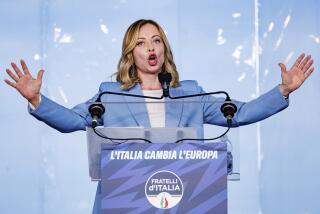World Cup ‘94: Days and Counting : ’90 Nightmare : Last World Cup Part of Network of Corruption That Left Italy Reeling and Changed It Forever
- Share via
ROME — It was scandalous, people said, when Italy failed to reach the finals in the World Cup it staged four summers ago.
Little did they know.
Investigators are still chasing billions of lire that inexplicably fell off trucks en route to Italia 90. Cell doors will be closing for years to come.
No one disputes the smooth operation of the tournament itself, any more than there is anything beyond lingering chagrin over Italy’s heartbreaking semifinal loss to Argentina on penalty kicks.
But all of Italy bears a grudge against the cozy cabal of big-shot politicians and businessmen who looted their country in the name of world soccer as part of a nationwide network of corruption.
Just as Italian soccer is different on the field today in part because of the Italia 90 results, so, too, is Italy a different country politically in its aftermath.
“The way in which Italian parties and cities approached the Mondiale was the last example of a bad way to approach public business,” said Luca di Montezemolo, who headed the Italia 90 organizing committee. “It was the last example of behavior that I hope is completely finished in Italy.”
Montezemolo, 46, president of the auto maker Ferrari, spent four years arranging Italy’s role as host for the tournament as head of the private organizing committee. In 12 cities across Italy, on the peninsula and in the islands of Sardinia and Sicily, the 52-game championship unfolded seamlessly.
Underlying the sport was massive infrastructural overhaul: telephone lines, television satellite links, roads, rail lines and stations, two new stadiums and exorbitant face lifts for the others.
“Overall it was a good thing,” Montezemolo said. “We have modern, safe stadiums, roads, an improved airport in Rome. More was accomplished around the event than in the previous 10 years. Unfortunately, Italy is a place where it is difficult to get things done if there is no pressure. Earthquakes, a World Cup, the Olympic Games, they make things happen. Events proved a good excuse to do things that wouldn’t be done without them.”
A month before the Cup began, all of Italy was a construction site. Nothing was ready; people despaired. Speaking with a Times reporter four weeks before the opening game, Montezemolo was asked if Italy would embarrass itself before the world: “I don’t know,” he replied.
To prepare for games that were seen as priceless international advertising for Italy, the national and local governments contracted big Italian companies for needed and ambitious public works budgeted at about $4 billion. They wound up paying much more.
One reason, it turned out later, was that there were so many greedy fingers in the pie. Rome’s Olympic Stadium, site of the final, cost almost three times more to enlarge and improve than the original estimate. Milan’s San Siro Stadium and Naples’ San Paolo are among the targets of corruption probes. Also being investigated are circumstances surrounding the construction of multimillion-dollar white elephant train stations in Rome built for the Cup but now abandoned.
“I would never do it again,” Montezemolo said. “They were four terrible years, always fighting with people, trying to explain that our committee had nothing to do with the infrastructure. It was good to modernize, but not the cost.”
About 18 months after Italia 90, magistrates in Milan began unraveling what has become the biggest scandal in Italian history: The World Cup was just one savory dish on a banquet table of corruption in which businesses paid off political parties and individuals in exchange for government contracts.
Popular revulsion triggered a revolt at the polls earlier this year: Italy’s political establishment oversaw Italia 90 with well-fed smiles, but now the avuncular men and parties that ruled for more than four decades are in disgrace. More than 3,000 politicians and businessmen are implicated in probes of massive corruption in which soccer was only a modest sideline.
March elections brought to power right-wing parties promising clean government and led by billionaire media tycoon Silvio Berlusconi, a soccer fanatic whose holdings include champion AC Milan. “Today, with a different government, things could be different,” Montezemolo said. “We might be able to do the same with a different moral ethic.”
If Italy is a sadder but wiser place four years later, its national soccer team is also poorer, in the eyes of most of its fans.
The Italian team, which will play a final tuneup match against Costa Rica on Saturday at New Haven, Conn., flew to the United States Tuesday as 70% of callers were telling one national sports daily that they had no confidence in the team.
A 1992 housecleaning swept out many Italia 90 players, including high-scoring striker Salvatore Schillaci, as well as coach Azeglio Vicini, who was replaced by Arrigo Sacchi, winner of every title in sight at AC Milan.
Sacchi demands more exciting soccer than the traditional Italian catenaccio --pass-to-pass in a long chain. Sacchi looks for a more open game with more room for offense.
Seven or eight years ago, Italy played man-to-man defense. Today, the Azzurri, like many first division clubs, plays a zone defense, according to Giorgio Tutino, a Rome sportswriter who has covered Italian soccer for three decades.
“Italy used to play a long game, with key forwards and two or three defenders always back. That’s a recipe for 0-0, 1-0. Now Italy plays short--lots of attackers, lots of defenders,” Tutino said.
The trouble is, Italy hasn’t looked good in Cup warm-ups. It beat Switzerland, 1-0, in Rome last week, but the Swiss played better.
There are a lot of Italian nerves riding on their World Cup opener on June 18 against Ireland at East Rutherford, N.J. Some of them belong to Luca di Montezemolo.
“I’m trying to decide whether to go to the Ireland game,” said Montezemolo, who is vice president of third-division Bologna, a former first-division powerhouse trying to claw back up the ladder.
He’s been watching preparations for the Cup as a fan--and, deja vu, as a survivor.
“The Americans have many advantages,” Montezemolo said. “The mentality is different in the United States; there is a great willingness to volunteer; the pressure is also less because soccer is not as popular. Then, too, nobody expects huge new things from the United States; the country is already well-organized.
“But the Americans have disadvantages: Because the distances are huge; because I don’t think people will be as totally involved as in Italy. And because it is easy to make mistakes in something of this size.”
* The Times continues the second phase of its informational graphics series designed to increase readers’ knowledge of soccer leading up to the World Cup. The Soccer Expert will appear daily until the Cup starts June 17. C10
More to Read
Go beyond the scoreboard
Get the latest on L.A.'s teams in the daily Sports Report newsletter.
You may occasionally receive promotional content from the Los Angeles Times.






